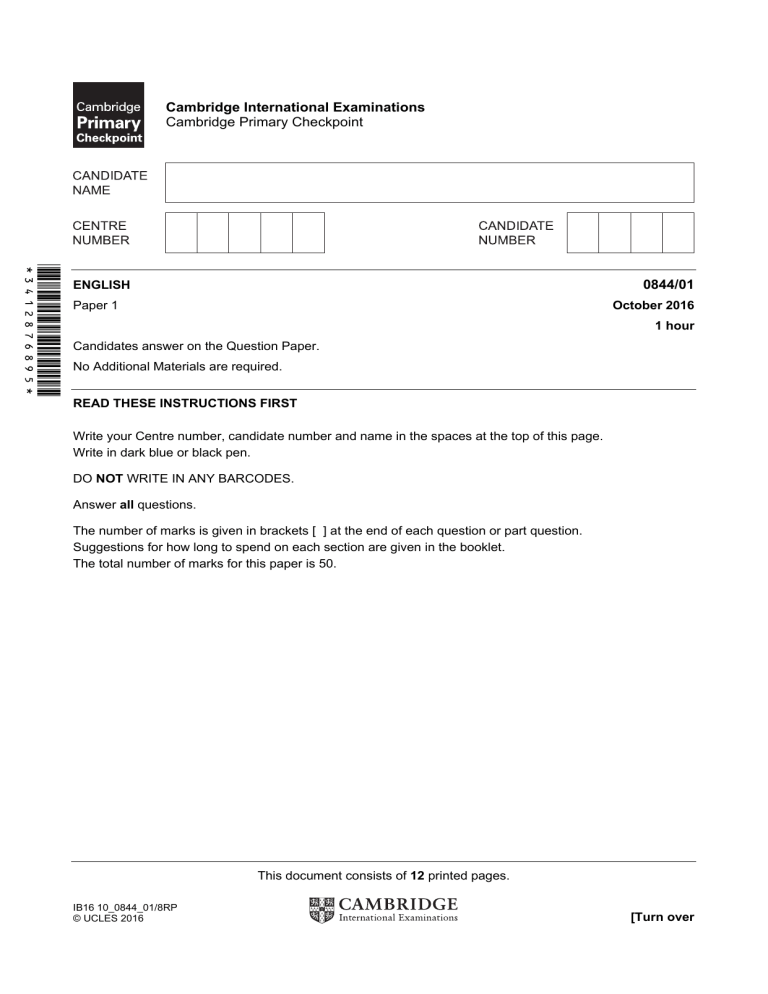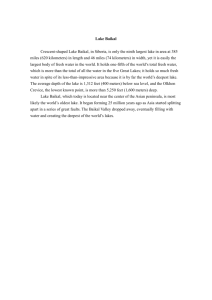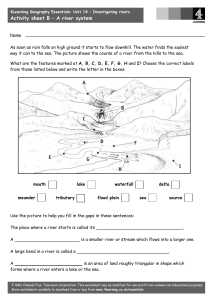
Cambridge International Examinations Cambridge Primary Checkpoint 0844/01 ENGLISH Paper 1 October 2016 1 hour Candidates answer on the Question Paper. No Additional Materials are required. READ THESE INSTRUCTIONS FIRST Write your Centre number, candidate number and name in the spaces at the top of this page. Write in dark blue or black pen. DO NOT WRITE IN ANY BARCODES. Answer all questions. The number of marks is given in brackets [ ] at the end of each question or part question. Suggestions for how long to spend on each section are given in the booklet. The total number of marks for this paper is 50. This document consists of 12 printed pages. IB16 10_0844_01/8RP © UCLES 2016 [Turn over 2 Section A: Reading Spend 20 minutes on this section. Read the text below about Lake Baikal, and then answer the questions. Lake Baikal Amazing facts! Surrounded almost entirely by mountains, the gigantic Lake Baikal is the world’s oldest lake. While most freshwater lakes are less than twenty thousand years old, it is estimated that this lake was created more than twenty-five million years ago. The lake runs for nearly 640 kilometres through south-eastern Siberia, just north of the Mongolian border. Although it is not the largest lake on Earth, with a depth of more than 1 600 metres, it is the deepest. It holds one fifth of the world’s total fresh water – more than any other freshwater lake on the planet. It contains more water than all the Great Lakes in North America put together! Many forms of life The lake’s deep, cold waters are surprisingly abundant with thousands of different plant forms and animal species. This is because of the lake’s unusually high oxygen levels. The oxygen allows a much wider variety of plants and animals to live in depths that would otherwise be unsuitable for life. Clear waters The lake has exceptionally crystal clear water. You can see as deep as 40 metres below its surface. This is probably due to the colossal population of crayfish that live there. They eat the algae and other particles in the water which, if left, would reduce the visibility. Weird and wonderful The lake’s remarkable qualities have made it home to a number of unusual and unique creatures. These include nerpa, the world’s only freshwater seals. These seals have two more litres of blood than other seals, allowing them to store more oxygen. This means they can dive 300 metres below the surface and can stay under water for an amazing 70 minutes! 1 According to the text, how old is the freshwater Lake Baikal thought to be? [1] 2 What is special about Lake Baikal that allows so many plants and animals to survive in such deep water? [1] © UCLES 2016 0844/01/O/N/16 3 3 Tick () two boxes to show which are true statements about Lake Baikal. It has the largest surface area of all the freshwater lakes in the world. It is in a very mountainous area. The lake contains no algae. It holds more fresh water than any other lake in the world. There are many different types of freshwater seal in the lake. [2] 4 Rewrite the last paragraph to include the main points, using no more than 30 words. [2] 5 Tick () the best description of the text Lake Baikal. It contains only facts. It contains mostly facts. It contains about half facts and half opinions. It contains only opinions. [1] © UCLES 2016 0844/01/O/N/16 [Turn over 4 6 Compare these texts. Text 1 Text 2 Here’s something you’ll find funny. Scientists have absolutely no idea how, or when for that matter, seals managed to get themselves to a lake in the middle of Russia – which is zillions of miles from the nearest ocean. Weird, hey? The presence of seals in the deep interior of Russia has puzzled evolutionary biologists. They are uncertain as to how, or at which time, the animals came to be so far from the open ocean. The information in both texts is the same but the language used is different. Tick () the text you prefer to read. Text 1 Text 2 Explain why you chose that text. [1] © UCLES 2016 0844/01/O/N/16 5 Read this text about a type of fish, and then answer the questions. The golomyanka The golomyanka is an unusual little fish, unique to Lake Baikal. It is 15–20 centimetres long and has a translucent body with no scales. Nearly 40% of its body weight is oil, which means it can swim at the bottom of the lake in depths of 1 400 metres. The pressure at such a depth is capable of crushing steel, but these oily fish are unaffected by it. As so much of the body mass of the golomyanka is oil, it must remain in waters of five degrees Celsius or lower. If the water is any warmer than this, the fish literally melts, leaving behind a skeleton and a pool of oil. For this reason, the fish only comes to the surface at night and remains in deep water during daylight. The golomyanka is the only fish in the northern hemisphere to give birth to live young. When the female is approximately two years old, she produces between 2 000 and 3 000 independent larvae and then dies. Due to the large number of golomyanka, it is the main food source of nerpa seals. Although there are thought to be about 150 000 tons of the fish in Lake Baikal, golomyanka are solitary creatures which do not form groups or shoals. This makes them difficult to catch, so they are not fished on any major scale, but local people use their oil for medical remedies. 7 (a) What is special about the body of the golomyanka that allows it to swim in deep water? [1] (b) Why is it difficult to catch the golomyanka in large numbers? [1] © UCLES 2016 0844/01/O/N/16 [Turn over 6 8 Tick () two boxes to show which statements are FALSE. People use the fish oil in some medicines. The golomyanka is not hunted by any other animals in Lake Baikal. The female golomyanka’s life cycle lasts about two years. You cannot find the golomyanka anywhere else in the world apart from Lake Baikal. After giving birth, the golomyanka takes care of its young. [2] 9 Suggest a reason why the golomyanka stays in deep water during sunlight. [1] © UCLES 2016 0844/01/O/N/16 7 10 This question refers to both texts. (a) What is the purpose of the sub-headings in the text Lake Baikal? [1] (b) In the text The golomyanka, paragraphs are used. Draw lines to link each paragraph to its sub-heading. 1st paragraph Giving birth 2nd paragraph Swimming alone 3rd paragraph Beating pressure 4th paragraph Staying cool [1] © UCLES 2016 0844/01/O/N/16 [Turn over 8 Section B: Writing Spend 25 minutes on this section. 11 The reading texts Lake Baikal and The golomyanka are both reports taken from information books. Write your own report for an information book about a place of geographical or historical interest. It could be: of geographical interest a mountain / mountain range a volcano a forest a river of historical interest an important building a city a landmark a temple a bridge PLANNING Spend about five minutes making notes in this box: Purpose and audience [6] Punctuation [2] Text structure [5] Spelling [2] Sentence structure [5] © UCLES 2016 0844/01/O/N/16 9 Write your report here: © UCLES 2016 0844/01/O/N/16 [Turn over 10 Section C: Grammar, Punctuation and Vocabulary Spend 15 minutes on this section. 12 Join the underlined word in each of these sentences to match the correct word class. The lake has a much wider variety of plants than most other lakes. Native Siberians use the fish oil medicinally. verb adjective In winter, Lake Baikal can remain frozen for more than five months. noun The golomyanka is a type of freshwater fish. adverb [2] 13 (a) Underline the main clause in this sentence. As the golomyanka’s body is translucent, it sparkles in the sunlight. [1] (b) Rewrite this sentence: The omul is a popular fish on all the local menus. Include this clause: which is caught in Lake Baikal Remember to add punctuation. Do not add or change any words. [2] © UCLES 2016 0844/01/O/N/16 11 14 (a) Change this sentence from the present to the past. Local people catch golomyanka so that they can use the oil to fuel their lanterns. [1] (b) Complete the sentences below by writing the passive form of the verb given in brackets. Golomyankas (find) are found in Lake Baikal. Still today, nerpa seals (hunt) for their fur and meat. A railway line (build) around the lake in the 1890s. The oil from the golomyanka (use) for hundreds of years. by local people [2] 15 Correct two mistakes in this sentence. Do not change the meaning. The fish known as the golomyanka is unusual beautiful because of the way it sparkle in the sunshine. [1] 16 Choose the type from simple, compound or complex to describe these sentences. Sentence Type of sentence As Lake Baikal is situated far inland, it is a mystery how seals got there. The nerpa seal is also known as the Lake Baikal seal. [1] © UCLES 2016 0844/01/O/N/16 [Turn over 12 17 Add two apostrophes to this sentence: I n t h e f r o z e n l a n d s c a p e s o f S i b e r i a, t h e r e s o n e o f t h e w o r l d s m o s t d i v e r s e a r e a s o f n a t u r a l b e a u t y. [1] 18 Add the missing punctuation to these sentences: “Did you see any nerpa seals when you visited Lake Baikal I asked my f r i e n d. “No he replied they are apparently very shy creatures” [2] 19 Reread this sentence from the text Lake Baikal: This is probably due to the colossal population of crayfish that live there. Write other words or phrases that mean the same as the underlined words. Your new words must keep the meaning and make sense in the sentence. due to [2] colossal Permission to reproduce items where third-party owned material protected by copyright is included has been sought and cleared where possible. Every reasonable effort has been made by the publisher (UCLES) to trace copyright holders, but if any items requiring clearance have unwittingly been included, the publisher will be pleased to make amends at the earliest possible opportunity. To avoid the issue of disclosure of answer-related information to candidates, all copyright acknowledgements are reproduced online in the Cambridge International Examinations Copyright Acknowledgements Booklet. This is produced for each series of examinations and is freely available to download at www.cie.org.uk after the live examination series. Cambridge International Examinations is part of the Cambridge Assessment Group. Cambridge Assessment is the brand name of University of Cambridge Local Examinations Syndicate (UCLES), which is itself a department of the University of Cambridge. © UCLES 2016 0844/01/O/N/16



